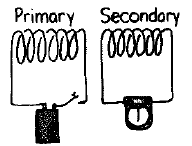
Concept explainers
Two separate but similar coils of wire are mounted close to each other, as shown below. The first coil is connected to a battery and has a direct current flowing through it. The second coil is connected to a galvanometer. How does the galvanometer respond when the switch in the first circuit is closed? When the current is steady after the switch is closed? When the switch is opened?

To Explain: The response of the galvanometer when the current is steady, and the switch is closed and open.
Answer to Problem 25A
The galvanometer responds when the switch is opened and closes but not when the current reaches a constant value.
Explanation of Solution
Introduction:
A galvanometer is a device that shows the current flowing in the circuit.
When the switch is closed, current flows in primary coil and a magnetic field generates due to the current. So, there will be a change in the magnetic field linked with the coils. A voltage is induced in the secondary coil due to this change in magnetic field. There will be some deflection in the galvanometer as the current is induced in the secondary coil.
As the current reaches a steady-state, there will no change in the magnetic field associated with the secondary coil and hence, no deflection in the galvanometer.
As the switch is opened, the galvanometer shows deflection but opposite in direction as that of when the switch was closed.
Conclusion:
The galvanometer shows a reading when there is a change in the magnetic field linked with the coil.
Chapter 37 Solutions
Conceptual Physics: The High School Physics Program
Additional Science Textbook Solutions
Introductory Chemistry (6th Edition)
Organic Chemistry (8th Edition)
Anatomy & Physiology (6th Edition)
Cosmic Perspective Fundamentals
Human Physiology: An Integrated Approach (8th Edition)
Campbell Biology (11th Edition)
- please solve and answer the question correctly. thank you!! (hint in 2nd photo)arrow_forwardNewton's Laws of Motion - Please help with the first angle calculations of standard deviation and margin of error. I just need a model and I can figure out the other two angles. Thanks!arrow_forward2. A battleship simultaneously fires two shells at enemy ships. If the shells follow the parabolic trajectories shown, which ship gets hit first? a. A b. both at the same time C. B d. need more information battleship Barrow_forward
- A m₁ = 1.70-kg aluminum block and a m₂ = 8.00-kg copper block are connected by a light string over a frictionless pulley. The two blocks are allowed to move on a fixed steel block wedge (of angle 0 = 31.5°) as shown in the figure. (For aluminum on steel, μk k = 0.36.) Мк Aluminum m Copper = 0.47. For copper on steel, Steel m2 Ꮎ (a) the acceleration of the two blocks m/s² (b) the tension in the string Narrow_forwardWhile the 83.3 kg Dora Milaje is in equilibrium, the rope makes a 70.0˚ angle with the horizontal. Assuming the coefficient of friction between her shoes and the ship is 0.772 and her static friction is at its maximum value, what is the tension in the cable?arrow_forwardCan someone help me asnwer this thank youarrow_forward
- Please solve and answer the problem correctly please. Be sure to give explanations on each step and write neatlyplease. Thank you!! ( preferably type the explantion, steps and solution please )arrow_forwardA square coil that has 17.5 cm on each side containing 17 loops lies flat on your desk as shown on this page. A uniform magnetic field of magnitude 4.60 × 10-ST points into this page. If a 8.50-A clockwise Current flows through the coil. ca) determine the torque on the coil. N.m (b) which edge of the coil rises up? choose one 。 Bottom отор and explain. O Right • None of these О Left.arrow_forwardA circular loop of wire with a diameter of 13.0 cm is in the horizontal plane and carries of 1.70 A clockwise, as viewed from underneath. What is the magnitude magnetic field as the center of the loop? -T what is the direction of magnetic field at the center or down? please explain. of the loop? uparrow_forward
 College PhysicsPhysicsISBN:9781305952300Author:Raymond A. Serway, Chris VuillePublisher:Cengage Learning
College PhysicsPhysicsISBN:9781305952300Author:Raymond A. Serway, Chris VuillePublisher:Cengage Learning University Physics (14th Edition)PhysicsISBN:9780133969290Author:Hugh D. Young, Roger A. FreedmanPublisher:PEARSON
University Physics (14th Edition)PhysicsISBN:9780133969290Author:Hugh D. Young, Roger A. FreedmanPublisher:PEARSON Introduction To Quantum MechanicsPhysicsISBN:9781107189638Author:Griffiths, David J., Schroeter, Darrell F.Publisher:Cambridge University Press
Introduction To Quantum MechanicsPhysicsISBN:9781107189638Author:Griffiths, David J., Schroeter, Darrell F.Publisher:Cambridge University Press Physics for Scientists and EngineersPhysicsISBN:9781337553278Author:Raymond A. Serway, John W. JewettPublisher:Cengage Learning
Physics for Scientists and EngineersPhysicsISBN:9781337553278Author:Raymond A. Serway, John W. JewettPublisher:Cengage Learning Lecture- Tutorials for Introductory AstronomyPhysicsISBN:9780321820464Author:Edward E. Prather, Tim P. Slater, Jeff P. Adams, Gina BrissendenPublisher:Addison-Wesley
Lecture- Tutorials for Introductory AstronomyPhysicsISBN:9780321820464Author:Edward E. Prather, Tim P. Slater, Jeff P. Adams, Gina BrissendenPublisher:Addison-Wesley College Physics: A Strategic Approach (4th Editio...PhysicsISBN:9780134609034Author:Randall D. Knight (Professor Emeritus), Brian Jones, Stuart FieldPublisher:PEARSON
College Physics: A Strategic Approach (4th Editio...PhysicsISBN:9780134609034Author:Randall D. Knight (Professor Emeritus), Brian Jones, Stuart FieldPublisher:PEARSON





